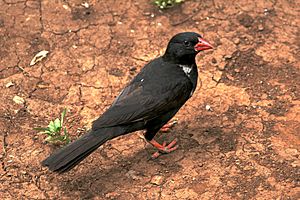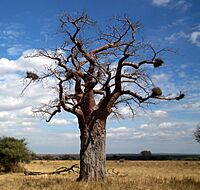Red-billed buffalo weaver facts for kids
Quick facts for kids Red-billed buffalo weaver |
|
|---|---|
 |
|
| Conservation status | |
| Scientific classification |
The red-billed buffalo weaver (Bubalornis niger) is a type of bird found in eastern and southern Africa. It belongs to the Ploceidae family, also known as weaver birds. These birds usually live in dry areas called savannas.
Contents
About the Red-Billed Buffalo Weaver
Red-billed buffalo weavers are medium-sized birds. They are about 21 to 25 centimeters (8 to 10 inches) long. Males weigh around 82 grams (2.9 ounces), and females are a bit lighter at about 71 grams (2.5 ounces). They might be the largest of all the weaver birds!
It's hard to tell males and females apart just by looking at them. The red-billed buffalo weaver is different from its cousin, the white-billed buffalo weaver, because of its beak color.
What They Look Like
Male red-billed buffalo weavers have dark chocolate brown feathers. Their front wing edges and wing tips have small white spots. Their beak is red, their eyes are brown, and their feet are reddish-brown.
Female birds are also dark chocolate brown. However, they do not have the white spots on their wings. Instead, their chin and throat feathers have wide white edges. Their eyes are dark brown, and their legs are light brown. Young birds are a lighter shade of brown than the adults.
What They Eat and How They Find Food
Red-billed buffalo weavers mainly eat insects, seeds, and fruit. Some of their favorite insects include crickets, locusts, grasshoppers, caterpillars, and beetles. They also eat wasps, bees, ants, flies, and even spiders and scorpions!
These birds find most of their food on the ground or in low plants. This means they spend a lot of time searching for food close to the earth. Changes in weather usually do not affect how much food they can find.
Where They Live
These birds like to live in dry savannahs and open woodlands. They often choose places where humans and farm animals are present. In fact, if people leave an area, the red-billed buffalo weavers living there often leave too. This means that as towns grow, these birds can find more places to live. They also live in groups, so having many birds in one area is not usually a problem for them.
How They Behave and Live Together
Red-billed buffalo weavers can be seen in small family groups or in large flocks.
Family Life
Male red-billed buffalo weavers often have many partners. One male might control one to eight nest areas, sharing them with three females. Usually, there is one main male who has the most nest areas and the most females. Other males in the group have fewer nest areas and fewer females. These males protect their nest areas and females by acting tough and making loud calls. Sometimes, two males will work together to build a nest, protect their space, and help feed the baby birds.
Female birds do not like other females in their nest area when they are laying eggs. Females usually feed the baby birds, unless they are part of a group where everyone helps. The food they bring includes insects, seeds, and fruit found near the nest.
Reproduction and Life Cycle

Red-billed buffalo weavers build their nests in groups, forming colonies. Their nests are huge piles of thorny twigs. Inside these piles are separate sections, like small apartments, each with many egg chambers. Each chamber has a smaller nest, which the female usually builds. This smaller nest is made of grass, leaves, and roots.
The whole big nest is often found in a thorny tree or even on a windmill near places where people live. Just like with their homes, if humans leave an area, the red-billed buffalo weavers often leave their nests there too. Interestingly, White-backed vultures and bateleurs sometimes build their nests above the buffalo weaver nests. This helps hide the weaver nests from predators.
Eggs and Chicks
The egg-laying season can last from September to June, but most eggs are laid between December and March. Females lay about 2 to 4 eggs. They sit on the eggs for about 14 days to keep them warm until they hatch. Only the female takes care of the eggs during this time. After 20 to 23 days, the young birds are ready to leave the nest.
Conservation Status and Threats
The red-billed buffalo weaver is currently listed as "least concern" (LC) by the IUCN. This means they are not in danger of disappearing. While we don't know the exact number of these birds worldwide, they are common, and their population is stable. There are no special groups or programs set up right now to watch over them or protect them.
However, red-billed buffalo weavers do have predators. Hawks, eagles, snakes, and baboons hunt both adult and young birds.


